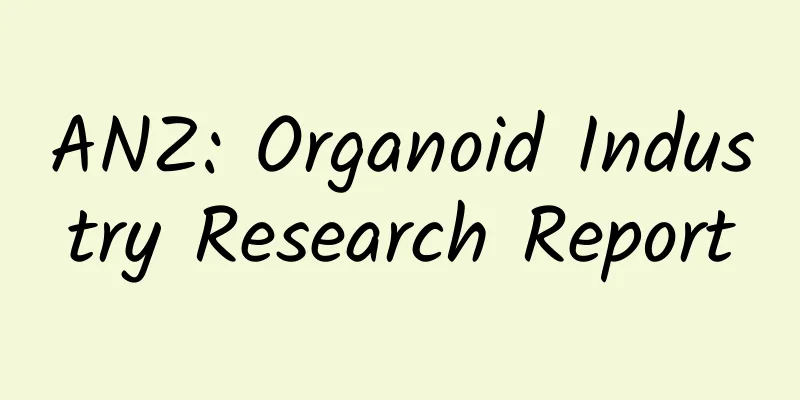ANZ: Organoid Industry Research Report

|
Over the past decade, the development of organoids has been hailed as one of the most exciting advances in stem cell research. The term “organoid” was first coined in the 1980s, but it was not until 2009 that the team of Dutch scientist Hans Clevers successfully cultured Lgr5+ intestinal stem cells in vitro into three-dimensional structures with crypt-like and villus-like epithelial regions, namely small-intestinal organoids, which opened a new chapter of rapid development in organoid research [1] . In 2013, organoids were named one of the top ten technologies of the year by Science. In early 2018, organoids were named the best method of 2017 by Nature Method. Currently, a variety of organ organoids have been successfully constructed, including the small intestine, stomach, colon, lungs, bladder, brain, liver, pancreas, kidneys, ovaries, esophagus, heart, etc., including not only normal organ tissue organoids, but also corresponding tumor tissue organoids. In recent years, searching for "Organoids" in PubMed's publicly available literature shows that the number of literature related to organoid technology has increased sharply, including many articles in top journals such as CNS. The number of organoid literature published by China has jumped from sixth place in the world (2009-2019) to second place (2020), second only to the United States. The improvement of China's scientific research accumulation will accelerate the process of organoid industrialization. Applying organoid technology to clinical practice to guide clinical drug use and precision treatment is the main development direction of organoid technology in the near future. In fact, organoid technology has been included in clinical trials since 2016. As of September 2020, 63 clinical trials have been officially registered with the FDA. There are 20 organoid clinical trial studies registered in China since 2017 and approved by the ethics committee, covering 8 types of cancer. The main focus is on the prediction of the efficacy of chemotherapy methods, but some studies have begun to focus on the application of immunotherapy in organoids (Changhai Hospital, PD-1). Judging from the distribution of cancer types, the cancers currently studied in China are mostly digestive system tumors, pancreatic tumors, and breast tumors. The humanized animal transplant model (PDX) is a tumor model in which tumor tissue is transplanted into immunodeficient mice. The main problems include low transplantation success rate, high construction cost, long cycle, and great limitations on the throughput of drug screening. In addition, there is a certain gap between the tumor microenvironment in immunodeficient mice and that in humans, and the transplanted tumor tissue may also undergo mouse-like evolution. A drug screening model that can be promoted clinically for tumors must be able to meet three basic requirements, including the need to produce drug sensitivity test results in a short period of time, high drug screening throughput, and accurate prediction of effects. Organoids have shown strong advantages in these three aspects compared to other drug screening methods. 1. Fast The success rate of organoid construction is high and the culture speed is fast. Generally speaking, drug screening can be carried out one week after organoid culture. The entire process from sample collection to the issuance of drug sensitivity results can be well controlled within 2 weeks [4] . 2. High throughput In terms of the drug throughput that can be screened, organoids can not only screen multiple drugs on the well plate, but each drug can also be tested at different concentrations, and multiple experiments can be carried out in parallel. 3. Strong clinical relevance The clinical relevance and predictive validity of organoids for cancer drug screening have been fully confirmed in many studies. Vlachogiannis G's team published a landmark study in Science on the use of in vitro drug sensitivity testing of tumor organoids to guide clinical drug use. They extracted 110 tissues from 71 patients with metastatic gastrointestinal cancer to construct organoids and tested a total of 55 anticancer drugs. The results showed that organoid drug screening achieved 93% specificity, 100% sensitivity, 88% positive predictive rate, and 100% negative predictive rate, demonstrating extremely high clinical relevance [5] . The scientific research application of organoids is currently mainly focused on disease model research and efficacy prediction. At present, many universities and hospitals have carried out corresponding scientific research, such as the Chinese Academy of Sciences, Tsinghua University, Zhejiang University, Beijing Tiantan Hospital, and Zhejiang University First Affiliated Hospital. The advantages and potential of the PDO technology route compared with the traditional route have been recognized by the academic community. In 2019, the number of academic papers containing organoids published by PUBMED has exceeded the number of PDX model papers published annually. In 2017, there were 20 organoid-related clinical trials registered in China or approved by the ethics committee. However, the organoid research market will see a relative slowdown in growth in the future, and organoid service providers will focus on selling reagents and consumables. As the research market further develops, research institutions will build and optimize their own platforms for cultivation and testing, but the highly customized needs of the research market make it difficult to provide standardized services. Clinical research applications are currently mainly used to provide precision treatment for patients in the middle and late stages of cancer. Direct drug trials on patients are time-consuming, risky, and painful, especially for cancer patients who lack effective drugs and can only undergo chemotherapy. It is difficult to find effective solutions in a timely manner. Organoids can replace patients in drug trials and achieve precision treatment. Currently, organoids are mainly used to detect the sensitivity of chemotherapy drugs, but they have greater potential for use in targeted drugs and immunotherapy in the future. At present, hospitals including Nanfang Hospital, Changhai Hospital, West China Hospital, and Fudan University Affiliated Cancer Hospital have carried out corresponding clinical research. At present, the clinical market for organoids is still in the development stage: due to the lack of written guidelines, patient awareness and clinicians' willingness to submit for examination are limited. With the increase in the clinical application of PDO, it is expected that under the trend of precision treatment, the demand for PDO in the clinical market will increase significantly. Organoids are of great value to patients, especially for cancer patients who lack effective drugs and can only be treated with chemotherapy. They can be used as an effective tool to achieve precision treatment. The application of organoids in the commercial market is mainly in the development of new drugs and the expansion of indications. Currently, about 85% of preclinical drugs fail in development after entering clinical trials, resulting in huge costs and losses. Organoids can be used for more comprehensive preclinical efficacy evaluation, which is of great value for reducing the cost of later drug development. In the development of anti-tumor drugs, PDO can reflect tumor heterogeneity at high throughput and low cost, effectively making up for the shortcomings of PDX animal models. Organoids are used as "patient substitutes" in Phase 0 "quasi-clinical trials", which can improve the success rate of clinical trials. At present, foreign pharmaceutical companies include Roche, Lilly, etc., and domestic companies including Innovent Biologics, Hengrui, Qilu Pharmaceuticals, and WuXi AppTec and other pharmaceutical companies and CROs are also involved. At present, the organoid drug research and development market is still in its initial stage, and pharmaceutical companies are still in the wait-and-see stage. The current revenue of organoid companies mainly comes from verification services. Organoids are not a must for new drug submissions, and pharmaceutical companies still follow the applicability strategy. In addition, the maturity of organoid technology and the inventory of samples are still limited, which has become the main concern for decision-making. However, it is undeniable that organoid technology can greatly enable pharmaceutical companies to do risk management, reduce costs and increase efficiency, and the drug research and development market will have the greatest commercial value. In the context of me-too, pharmaceutical companies have a sharp increase in demand for reducing costs and increasing efficiency and improving the success rate of new drug research and development. In the future, the willingness to pay for the value brought by organoids will be stronger than other markets. On January 28, 2021, the Ministry of Science and Technology issued the "Notice on Soliciting Opinions on the 2021 Project Application Guidelines for Six Key Special Projects in the 14th Five-Year Plan National Key R&D Program", which listed "Organoid-based Malignant Tumor Disease Model" as the first batch of key special project tasks to be launched in the 14th Five-Year Plan National Key R&D Program. On November 30, 2021, the Center for Drug Evaluation of the National Medical Products Administration issued the "Technical Guidelines for Nonclinical Research and Evaluation of Gene Therapy Products (Trial)" and the "Technical Guidelines for Nonclinical Research of Gene-modified Cell Therapy Products (Trial)" (1), which for the first time included organoids in the guidelines for gene therapy and gene-modified cell therapy products. Compared with traditional animal experiments, microfluidic chips have three technical advantages: (2) Better simulation of the in vivo environment and response : ability to control cells and specific tissue structures, and the ability to vascularize and perfuse tissues; (3) Facilitate monitoring of health status and dynamics: Incorporate real-time tissue function sensors such as microelectrodes or optical microscopy markers (such as fluorescent biomarkers). (1) Difficulties in integration technology : Scientific research field: Domestic scientific research field mostly uses membranes, but the processing cost is very high. Many scientific research institutions in schools are doing membrane integration, but they are not doing well. Commercial field: Most of them are completed on culture dishes/culture dish-like structures with the help of water flow and pressure. The technical difficulty of using membrane structures is greater than membrane integration and membrane processing technology. As a complete system, culture dishes are difficult to integrate. ( 2) Low repeatability: The regulation of drug concentration and the final sample collection cannot be repeated every time. The cost-effectiveness is not high. (3) Hardware barriers: The gap with foreign countries mainly lies in the accuracy and durability of lithography machines. The current difficulties of Biobank are: 1. The sample library contains limited tissues, and the number of organoid models and the cancers they cover are far less than those of pdx: 1a. Mainly stored are mainstream cancers: lung cancer, colorectal cancer, stomach cancer, breast cancer, and other more common ones are pancreatic cancer and head and neck cancer. 1b. Since organoid companies mainly obtain samples by providing drug sensitivity testing, the storage capacity of normal tissue organoids is very limited. 2. The cost of culturing and maintaining organoid models is high, and the technology is also insufficient. The failure rate of organoid recovery and expansion is high, and the stability of cryopreservation needs to be further explored. In the field of organoids, China has shown a significant increase in the number of scientific research in recent years, especially in the two years from 2019 to 2020, showing a strong development momentum. The number of published papers has jumped from sixth place in the world (2009-2019) to second place (2020), second only to the United States. Referring to Table 5, it can be found that there are relatively few companies focusing on organoids abroad. Many companies originally focused on stem cell-related businesses and later expanded into organoids. Due to the above barriers, there are not many organoid companies in China that conduct tumor drug screening, but companies that have successfully raised funds (such as Ketu, Chuangxin, etc.) have the ability to independently develop innovative organoid consumables, and have their own unique know-how in all aspects of organoid cultivation. Compared with foreign countries, their progress in industrialization has not lagged behind significantly. Judging from the number and amount of investment and financing, the entire organoid industry is still in a relatively early stage, and the organoid industry has not yet formed a centralized industrial cluster in China. Competition has just started, and companies with core technological advantages and a complete production chain that layout the industry as early as possible will have a first-mover advantage. Another opportunity for development is that, at present, the industry at home and abroad has not yet established complete standards. Therefore, Chinese organoid companies and research institutions can actively participate in the standardization of organoid technology and the establishment of application guidelines, and thus gain a dominant advantage and voice in the industry in the future [11] . 2. In vitro β-cell organoids are expected to provide a new solution for pancreatic islet regeneration 2. Immunization. In addition to vascularization, the difficulty also includes simulating the interaction between tumors and the immune environment. In 2019, Nature Protocol published a protocol for the co-culture of tumor organoids and immune cells, which can reflect and simulate some characteristics of the tumor microenvironment [6] . Taking the co-culture model of epithelial organoids and immune cells as an example, the interaction between organoids and immune cells can be reshaped by adding activated immune cells to the culture medium, growing them together with immune cells after the tissue is digested into single cells, and adding recombinant cytokines in the ECM. 3. Systematization. Compared with a single organoid, the construction of an organoid system can make a more complete and comprehensive evaluation of drug efficacy and potential toxicity. Currently, organoids can only detect the inhibitory effect of drugs on tumors, and cannot predict whether there are other side effects and safety risks in other organs and tissues. To solve this problem, in 2017 Skardal et al. constructed an organoid system composed of the heart, lungs, and liver integrated into a closed-loop control body to achieve the purpose of fully revealing the toxicity and efficacy of drugs on different organs [7] . In terms of vascularization, if organoids lack nutrient supply after being cultured for about 2 months, they will be quite different from organs in the body. However, for drug screening, as long as the organoids grow into cell spheres in a suitable environment, they can be used for drug screening. For example, if the research focus of a drug is the need to cross the blood-brain barrier, then the focus of brain organoid construction will be the need to have a complete blood-brain barrier structure, and other characteristics (such as the interaction between cells and surrounding blood vessels) may not be given priority. Vascularization, immune co-culture, and systematization can further improve the accuracy of organoid clinical predictions, but considering key application factors such as cycle time and cost, it is not possible to take all conditions into account. One day, if these characteristics can be achieved with controllable cost cycles, organoid drug screening will be able to provide more accurate answers. Map | Li Lening Editor | Huang Zien References:
Source: |
<<: Among all the major players, who can secure the position of the smart hardware manufacturer?
>>: When the fans of the original novel meet the fans of the adaptation, who will win?
Recommend
Operation decoding, do you know these little things about operations?
It is easy to enter the industry but difficult to...
Did Bai Juyi also suffer from depression? Is it the same as what we are talking about today?
Therefore, the verses written on the river bridge...
Have you ever heard of the peony? Where does this beautiful name come from?
Produced by: Science Popularization China Author:...
In the dark forest, have we been exposed?
In 1920, General Motors hired American inventor C...
To Mi Meng, free poison, paid aphrodisiac
Some people say that content monetization is noth...
Useful information | User portrait methods and practices in operational data analysis!
In daily business activities, there are various f...
How come there are still typhoons in November? Experts explain super typhoon "Connie"
Who would have thought that a super typhoon would...
Visualization丨"Tiangong Classroom" will start tomorrow! Review the knowledge points of the first two lessons
END Editor/Gulu...
APP Promotion丨3 major marketing scenarios to explain the way of precise delivery
What are the advantages and disadvantages of main...
Does this mean that all opened coconuts cannot be eaten?
Audit expert: Wang Guoyi Postdoctoral fellow in N...
Basic concepts in APP promotion: CPA, CPC, CPD
Let me first introduce to you: the basic concepts...
Why has “quantum supremacy” been verified so many times, but traditional computers are still “unconvinced”?
Quantum computing is making big news again! In Ju...
Evaluation of 16 Bluetooth headsets: Are the thousands of yuan headsets only good for making noise?
Since we launched the call for submissions in Jan...
How much does it cost to join the Shangluo Coupon Mini Program? What is the price for joining the Shangluo Coupon Mini Program?
How much does it cost to join a coupon mini progr...
Volkswagen Group (China) and Hainan Province deepen cooperation to promote local industrial development
[December 8, 2023, Haikou/Beijing] During the 202...









